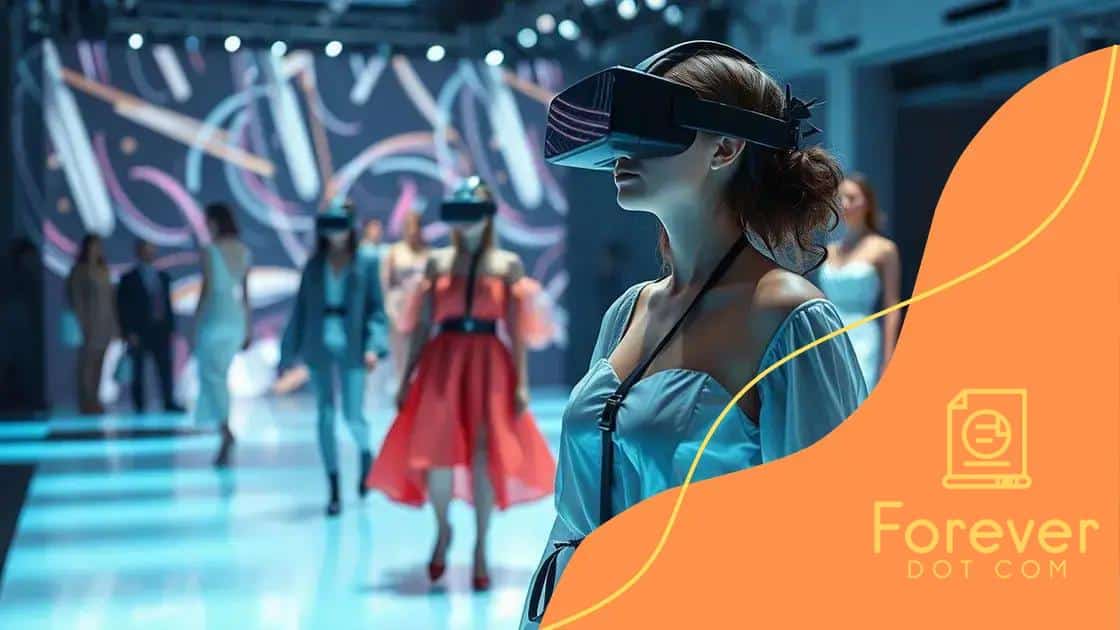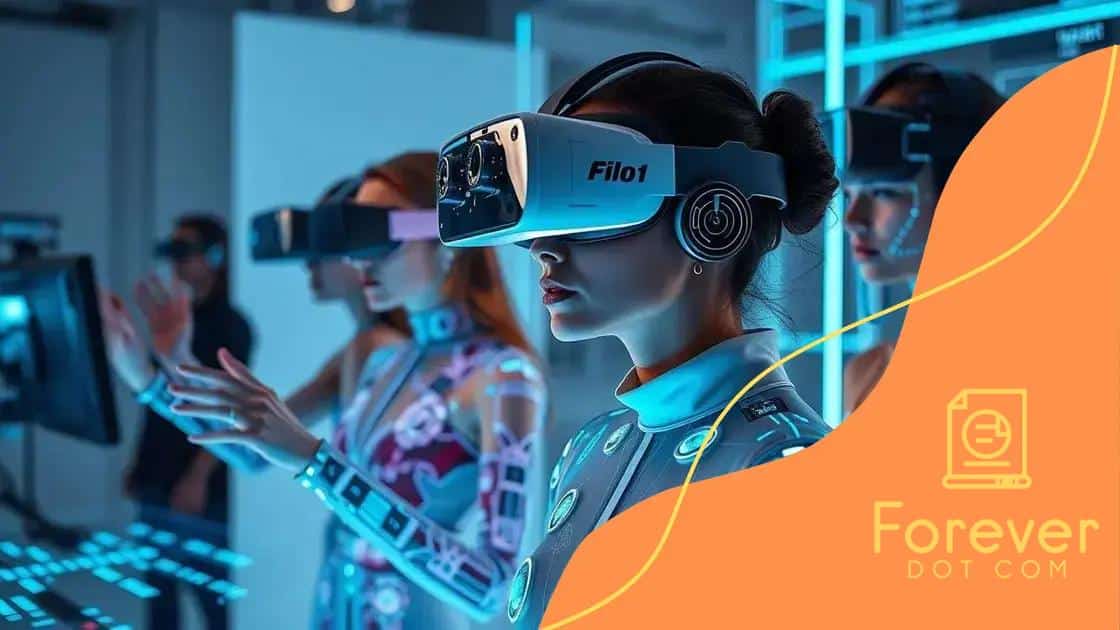The future of modeling in a tech-driven fashion world

The future of modeling in a tech-driven fashion world integrates artificial intelligence, virtual reality, and sustainable practices, reshaping design and consumer experiences while promoting inclusivity and environmental responsibility.
The future of modeling in a tech-driven fashion world is unfolding rapidly, blending creativity with cutting-edge technology. Have you wondered how digital advancements impact the modeling industry and redefine beauty standards?
The role of technology in modern fashion modeling
The role of technology in modern fashion modeling is crucial. It not only shapes how models present themselves but also influences the overall fashion industry. Today’s models leverage various tools to enhance their performance and appearance.
Adoption of Digital Tools
Digital platforms play a significant role. Models use applications that help them analyze their poses, improve their runway techniques, and tailor their portfolios. Social media has also transformed how models build their brands and connect with audiences.
Virtual and Augmented Reality
Virtual reality (VR) and augmented reality (AR) are changing the game. These technologies enable designers to create immersive experiences for viewers. Rather than simply viewing a collection, audiences can experience it in an engaging environment. This method also allows designers to showcase their collections without the need for a physical runway, making shows more accessible.
- Enhanced audience engagement through interacting with collections.
- Cost-effective alternatives to traditional shows.
- Access to a wider audience.
Another crucial aspect of technology in modeling is data analytics. Designers and agencies analyze trends to understand what consumers desire. By leveraging data, they can make informed decisions about styles, fabrics, and marketing strategies. As a result, models can adapt their looks and approaches to stay relevant.
AI in Fashion
Artificial intelligence is also a driving force in modern fashion. From predicting trends to analyzing social media movements, AI helps brands to stay ahead of the curve. Models can utilize AI-driven insights to enhance their performance, targeting specific markets effectively.
Improved photography techniques are also a product of technology. With advances in camera technology and editing software, photographers can produce stunning visuals that showcase the models and their fashion more effectively. This situation allows for creativity and innovation, making fashion photography more impactful.
In conclusion, the partnership between technology and fashion modeling is remarkable. As we look forward, these advancements will likely redefine how we perceive beauty and presentation in the fashion world.
Impact of virtual reality on fashion shows
The impact of virtual reality on fashion shows is transforming the way designers showcase their collections. This technology allows viewers to immerse themselves in a fully interactive experience, making fashion shows more engaging than ever.
Creating Immersive Experiences
With virtual reality, fashion shows can transport audiences into creative environments. Instead of just watching models walk the runway, people can explore different settings crafted by designers. This can enhance the storytelling aspect of the collection, immersing them in the theme and atmosphere.
- Enhanced storytelling through visual environments.
- Greater accessibility for remote audiences.
- Increased engagement with interactive elements.
Moreover, virtual reality allows designers to experiment with unconventional ideas. For example, they can create entirely fantasy worlds, breaking away from the limitations of physical spaces. This approach encourages creativity and pushes the boundaries of traditional fashion shows.
Broader Reach and Accessibility
One of the key benefits of integrating VR into fashion shows is the ability to reach a wider audience. People all over the world can attend virtual shows from the comfort of their homes. This not only increases visibility for designers but also democratizes fashion, allowing more viewers to experience cutting-edge designs.
Additionally, fashion brands can leverage data analytics from virtual shows. By tracking how viewers interact with their shows, brands can gather insights into audience preferences. This data is invaluable for tailoring future collections to meet consumer expectations.
As technology evolves, we can expect even more innovative uses for virtual reality in fashion. The potential for blending digital artistry with high fashion is limitless. Brands that embrace this shift will likely stand out in the competitive fashion landscape.
How AI is changing modeling techniques

How AI is changing modeling techniques is a fascinating topic that shows the intersection of technology and creativity. Models today benefit from various AI tools that enhance their performance and streamline processes.
Enhanced Image Processing
AI-driven image processing tools are revolutionizing how photographers edit and enhance photos. These applications can analyze images and automatically adjust lighting, colors, and even backgrounds. This technology makes the process quicker and helps in producing stunning visuals that captivate audiences.
- Faster editing times allow for more creativity.
- Improved precision in visual quality.
- Increased accessibility for models and photographers.
In addition to processing images, AI is also changing the way casting happens in the industry. With advanced algorithms, agencies can analyze portfolios and social media presence to find the right fit for campaigns. This method helps streamline the casting process, making it more efficient and targeted.
Virtual Models
Interestingly, AI is enabling the creation of virtual models. These digital avatars can be designed to represent different body types, ethnicities, and styles. Brands can utilize these virtual models in campaigns, reaching a broader audience while showcasing diverse representations. Additionally, using digital models can reduce costs associated with hiring real models for traditional photoshoots.
Moreover, AI technology can simulate how fabrics move and react in various environments. This ability gives designers invaluable insights during the design phase. They can predict how their designs will look on different body types and fabrics, improving fit and style before the actual production.
Overall, the integration of AI into modeling techniques encourages innovation and diversity. As technology continues to advance, the potential for AI in the fashion industry grows exponentially, promising a future filled with exciting transformations.
Sustainable fashion and tech innovation
Sustainable fashion and tech innovation are changing the landscape of the clothing industry. As the world becomes more aware of environmental issues, brands are looking for ways to create eco-friendly clothing options while utilizing new technologies.
Eco-Friendly Materials
One important aspect of sustainable fashion is the use of eco-friendly materials. Designers are exploring fabrics made from recycled plastic, organic cotton, and even innovative materials like mushroom leather. These materials reduce waste and help combat pollution.
- Recycled fabrics save resources and energy.
- Organic materials reduce harmful pesticides and chemicals.
- Innovative options offer alternatives to traditional fabrics.
Incorporating technology into the design process is also key. For example, 3D printing helps create custom pieces with minimal waste. This technology allows designers to make prototypes quickly and efficiently, minimizing the need for excess fabric that often ends up discarded.
Supply Chain Transparency
Another vital factor in sustainable fashion is transparency in the supply chain. Technology enables brands to track their products from creation to sale. Blockchain and tracking software can provide consumers with information about where their clothing comes from and how it is made. This transparency builds trust between brands and consumers.
Additionally, tech innovation helps reduce the carbon footprint of fashion. Automated production processes can lead to lower energy consumption while also speeding up the manufacturing timeline. As brands embrace these technologies, the industry can move toward a more sustainable future.
Ultimately, the collaboration between sustainability and technology is paving the way for a new era in fashion. Consumers are increasingly seeking brands that prioritize the planet, and technology is helping make that possible.
Future trends in fashion technology and modeling
Future trends in fashion technology and modeling are set to reshape the industry dramatically. As the world evolves, new technologies continue to emerge, influencing how fashion is designed, produced, and marketed.
Smart Fabrics
One exciting trend is the development of smart fabrics. These fabrics can respond to environmental changes, such as temperature or moisture, and can even monitor health metrics. For example, a dress could adjust to keep the wearer comfortable throughout the day.
- Smart textiles promote comfort and functionality.
- Wearable tech integrates seamlessly with fashion.
- Health monitoring features provide valuable data.
Additionally, advancements in 3D printing technology will play a significant role in the future of fashion. Designers will continue to create unique pieces with minimal waste. This printing method allows for precise designs and quick production, making it easier to bring concepts to reality.
Virtual Fashion Shows
Virtual fashion shows are also gaining popularity. They offer a unique opportunity for brands to reach wider audiences without the constraints of physical venues. By hosting online events, brands can showcase their collections globally, allowing anyone to experience fashion from anywhere.
Social media will continue to evolve as a platform for fashion marketing. With algorithms improving, brands will tailor their advertising to individual preferences, making promotions more effective. Influencers and digital marketing will flourish as tools for brand promotion.
Moreover, the integration of artificial intelligence will further personalize shopping experiences. AI will offer fashion suggestions based on past purchases and trending styles, making online shopping easier for consumers. This personalization creates a more engaging buying experience.
As the fashion industry embraces these new technologies, the landscape will undoubtedly shift, paving the way for innovative designs and unique experiences. The future of fashion will be marked by a blend of creativity and technology that captivates audiences worldwide.
FAQ – Frequently Asked Questions about Fashion Technology and Modeling
What role does technology play in modern fashion shows?
Technology enhances fashion shows by allowing for virtual events, which broaden accessibility and engagement without the constraints of physical locations.
How are sustainable practices changing the fashion industry?
Sustainable practices focus on eco-friendly materials and innovative production methods, reducing waste and environmental impact while promoting ethical fashion.
What are smart fabrics, and how do they benefit consumers?
Smart fabrics respond to environmental changes and can monitor health metrics, providing enhanced comfort and functionality for the wearer.
How is AI influencing shopping experiences in fashion?
AI personalizes shopping experiences by analyzing consumer preferences and offering tailored fashion recommendations, making online shopping more engaging.






